Fundamentals of Guitar Design – Part 3, Body Scoping Rules
So far, I’ve set about defining our task and describing some of the things we’ll be working with. This time, I’ll be delving more into how we see guitar bodies, and ways to help keep them from getting out of control. If you were to take a picture of a guitar body, any one will do, your eyes will go through several little rituals that help you articulate this new shape in your brain’s visual files. The order in which we do this will vary from person to person, and you may never have thought about it, but first, I think we try to grasp the overall shape at once, assigning it certain characteristics rather quickly, like is it; soft or angular, visually light or heavy, pleasing or disturbing, balanced, or irregular? We also generally trying to find something else to compare it to. (Hey, that looks like a fish!) I also categorize them into one of the Thrust Types from Part One of this series.
One immediate response is to run the eyes around the perimeter of the body, in a circuit I call the ‘Race’. This experience will be different for each guitar, and is worth studying for a few minutes. Ask yourself, where does your eye begin and end when running around this shape? Are its curves complimentary and self-similar? Does your eye get ‘caught’ anywhere, and if so why? Does this shape take into consideration the neck and headstock, or does it isolate itself as a unit? Is it a slow ride, or do you hurtle around? Does the Race follow, or fight, the overall Thrust of the body’s Axes? (see Part One) Sometimes it can run counter to it, and still not be a bad thing. Does any part of the body turn the eye away from the body, in a distracting way?
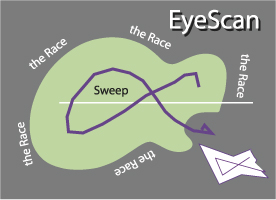
In Western Culture, quite often you’ll find that you start your Eye scan at the Top Left, for two major reasons. The first is that that’s how we read, left to right and top to bottom. The other reason is that the neck and head have less information in them, and tend to shoot the eye off to the right due to the lightness compared to the body’s weight. However it’s important to really look at it, repeatedly, and be honest with yourself about where your eyes really want to go. It can be anywhere.
The next thing I look for is what I call the Sweep, and that occurs further into the body… and is based on the comparative weight of each Bout, and how they relate to each other. Some bodies will have very little of this effect, (symmetric ones especially) but swoopier, more exciting shapes can really pull the eye around. It’s fun to set out to make this happen and see it work, a little private victory to savor.
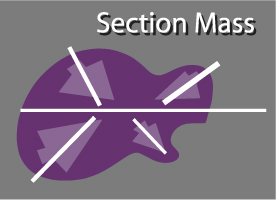
A large factor in the Sweep is what I call Section Mass, a byproduct of dividing the body up into four bouts. In addition to the main Axes across the main Spine, each sector will have a bisecting line that is assumed by the brain, based on where it is widest and thinnest. These bisectors should be complimentary as well, or at least not obviously at odds with each other. If one or more are ‘Out’, it’ll cause a haunting effect that ‘something ain’t right’. I find we look at each part first in its Center of Mass, or the big end, and then are led to the smallest area. This may be a purely ancient assessment of where we’d have to hit something to damage it severely, but that’s just a theory. Any irregular triangle will show this behavior, you will seek to find its base, and decide which way it is ‘pointing’, in aprocess I call Implied Direction.
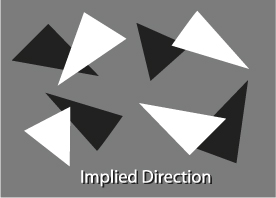
Another effect that can come into play is related to the Section Mass’s dividing the bouts, and happens most obviously when one cuts any sort of notch into the tail end. I call this the Scissor Effect, and you will find it can show up a second visual center that can be quite removed from its apparent ‘weighting center’. We can’t help it, we’ll always see that crossing point. If it’s too far off-center, or overwhelms the main center, it can cause unease, and one that can be elusive to discover. It’s something that must be judged by the Eye as to whether you’ve gone too far or not. Go ahead and draw the center lines on any design and see for yourself.
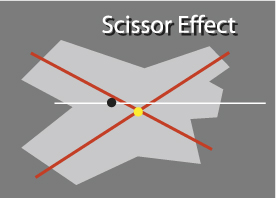
Making those hundreds of often tiny judgments is your primary function as a guitar designer, so don’t slough them off, they’re important. How you handle them will come forth as your ‘Hand’, or your visual signature. Some will have a very apparent, consistent style, (Think Peter Malinoski, or Jason Schroeder.) Others will seek to minimize their own handprint, and others seek to master all styles. It’s a decision you should try to make, and stick to.
Here’s a very simple trick that you can apply when designing a guitar, and especially in any drawing program you may be using on a computer. Once you’ve got your main Spine Line drawn and your body sized, rough-drawn, and rotated to look balanced, and are fairly happy with those things, a quick way to see how balanced it is is to use what I call balance bars.
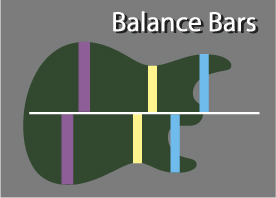
Simply measure the body at its widest and narrowest parts and check against the other side. In the computer, just drag a Box with your mouse (if you have a Snap-To-Line feature, use it to start at the center line). Then do two more. Repeat those three boxes, and reflect them (flip-flop) at the same size, and compare them against the other side of your body. You may be surprised at what this can show up. Sometimes a hand-drawing can look great even though it is way out. Perfect symmetry is not required, but these bars can be used to at least get a visual balance.
Next time, I’ll put some of these factors into play, and bring up one more important effect.
Kerry Kruger, Miami.

